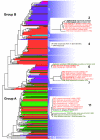Sebacinales everywhere: previously overlooked ubiquitous fungal endophytes
- PMID: 21347229
- PMCID: PMC3039649
- DOI: 10.1371/journal.pone.0016793
Sebacinales everywhere: previously overlooked ubiquitous fungal endophytes
Abstract
Inconspicuous basidiomycetes from the order Sebacinales are known to be involved in a puzzling variety of mutualistic plant-fungal symbioses (mycorrhizae), which presumably involve transport of mineral nutrients. Recently a few members of this fungal order not fitting this definition and commonly referred to as 'endophytes' have raised considerable interest by their ability to enhance plant growth and to increase resistance of their host plants against abiotic stress factors and fungal pathogens. Using DNA-based detection and electron microscopy, we show that Sebacinales are not only extremely versatile in their mycorrhizal associations, but are also almost universally present as symptomless endophytes. They occurred in field specimens of bryophytes, pteridophytes and all families of herbaceous angiosperms we investigated, including liverworts, wheat, maize, and the non-mycorrhizal model plant Arabidopsis thaliana. They were present in all habitats we studied on four continents. We even detected these fungi in herbarium specimens originating from pioneering field trips to North Africa in the 1830s/40s. No geographical or host patterns were detected. Our data suggest that the multitude of mycorrhizal interactions in Sebacinales may have arisen from an ancestral endophytic habit by specialization. Considering their proven beneficial influence on plant growth and their ubiquity, endophytic Sebacinales may be a previously unrecognized universal hidden force in plant ecosystems.
Conflict of interest statement
Figures


Similar articles
-
Sebacina vermifera: a unique root symbiont with vast agronomic potential.World J Microbiol Biotechnol. 2016 Jan;32(1):16. doi: 10.1007/s11274-015-1970-7. Epub 2015 Dec 29. World J Microbiol Biotechnol. 2016. PMID: 26715121 Review.
-
Communities of endophytic sebacinales associated with roots of herbaceous plants in agricultural and grassland ecosystems are dominated by Serendipita herbamans sp. nov.PLoS One. 2014 Apr 17;9(4):e94676. doi: 10.1371/journal.pone.0094676. eCollection 2014. PLoS One. 2014. PMID: 24743185 Free PMC article.
-
Do Sebacinales commonly associate with plant roots as endophytes?Mycol Res. 2009 Oct;113(Pt 10):1062-9. doi: 10.1016/j.mycres.2009.07.004. Epub 2009 Jul 17. Mycol Res. 2009. PMID: 19616625
-
Morphological and molecular analyses of fungal endophytes of achlorophyllous gametophytes of Diphasiastrum alpinum (Lycopodiaceae).Am J Bot. 2013 Nov;100(11):2158-74. doi: 10.3732/ajb.1300011. Epub 2013 Oct 18. Am J Bot. 2013. PMID: 24142907
-
Sebacinales - one thousand and one interactions with land plants.New Phytol. 2016 Jul;211(1):20-40. doi: 10.1111/nph.13977. Epub 2016 May 19. New Phytol. 2016. PMID: 27193559 Review.
Cited by
-
"Omics" Tools for Better Understanding the Plant-Endophyte Interactions.Front Plant Sci. 2016 Jun 29;7:955. doi: 10.3389/fpls.2016.00955. eCollection 2016. Front Plant Sci. 2016. PMID: 27446181 Free PMC article. Review.
-
Ericoid mycorrhizal root fungi and their multicopper oxidases from a temperate forest shrub.Ecol Evol. 2012 Jan;2(1):65-79. doi: 10.1002/ece3.67. Ecol Evol. 2012. PMID: 22408727 Free PMC article.
-
It Takes Two to Tango: A Bacterial Biofilm Provides Protection against a Fungus-Feeding Bacterial Predator.Microorganisms. 2021 Jul 23;9(8):1566. doi: 10.3390/microorganisms9081566. Microorganisms. 2021. PMID: 34442645 Free PMC article.
-
Mutualism-parasitism paradigm synthesized from results of root-endophyte models.Front Microbiol. 2015 Jan 12;5:776. doi: 10.3389/fmicb.2014.00776. eCollection 2014. Front Microbiol. 2015. PMID: 25628615 Free PMC article.
-
Harnessing symbiotic plant-fungus interactions to unleash hidden forces from extreme plant ecosystems.J Exp Bot. 2020 Jun 26;71(13):3865-3877. doi: 10.1093/jxb/eraa040. J Exp Bot. 2020. PMID: 31976537 Free PMC article. Review.
References
-
- Brundrett M. Mycorrhizal associations and other means of nutrition of vascular plants: understanding the global diversity of host plants by resolving conflicting information and developing reliable means of diagnosis. Plant Soil. 2009;320:37–77.
-
- Weiß M, Selosse M-A, Rexer K-H, Urban A, Oberwinkler F. Sebacinales: a hitherto overlooked cosm of heterobasidiomycetes with a broad mycorrhizal potential. Mycol Res. 2004;108:1003–1010. - PubMed
-
- Glen M, Tommerup IC, Bougher NL, O'Brien PA. Are Sebacinaceae common and widespread ectomycorrhizal associates of Eucalyptus species in Australian forests? Mycorrhiza. 2002;12:243–247. - PubMed
-
- Urban A, Weiß M, Bauer R. Ectomycorrhizae involving sebacinoid mycobionts. Mycol Res. 2003;107:3–14. - PubMed
-
- Selosse M-A, Weiß M, Jany J-L, Tillier A. Communities and populations of sebacinoid basidiomycetes associated with the achlorophyllous orchid Neottia nidus-avis (L.) L.C.M. Rich. and neighbouring tree ectomycorrhizae. Mol Ecol. 2002;11:1831–1844. - PubMed
MeSH terms
Substances
LinkOut - more resources
Full Text Sources
Molecular Biology Databases

